Tiny House Systems: Power, Water, and Wastewater as well as basic reduction of EMFs.
Type of Power
My tiny house is 100% electric. I could have gone with a propane on-demand hot water heater and possibly with a propane-powered fridge. Since these vent fully to the outside, they should be safe.
I decided not to because I would then have to deal with buying, transporting, and hooking up propane.
House insurance is also a little bit higher with propane hooked up. If you want to reduce the number of amps you are using then you will need some propane-powered systems. I would not use a propane stove though as the fumes are very toxic. If you can afford solar it might be a good idea but it won’t power much and then you have the added EMFs of the inverter.
This post contains affiliate links. Upon purchase, I earn a small commission at no extra cost to you.
Power Supply for a Tiny House
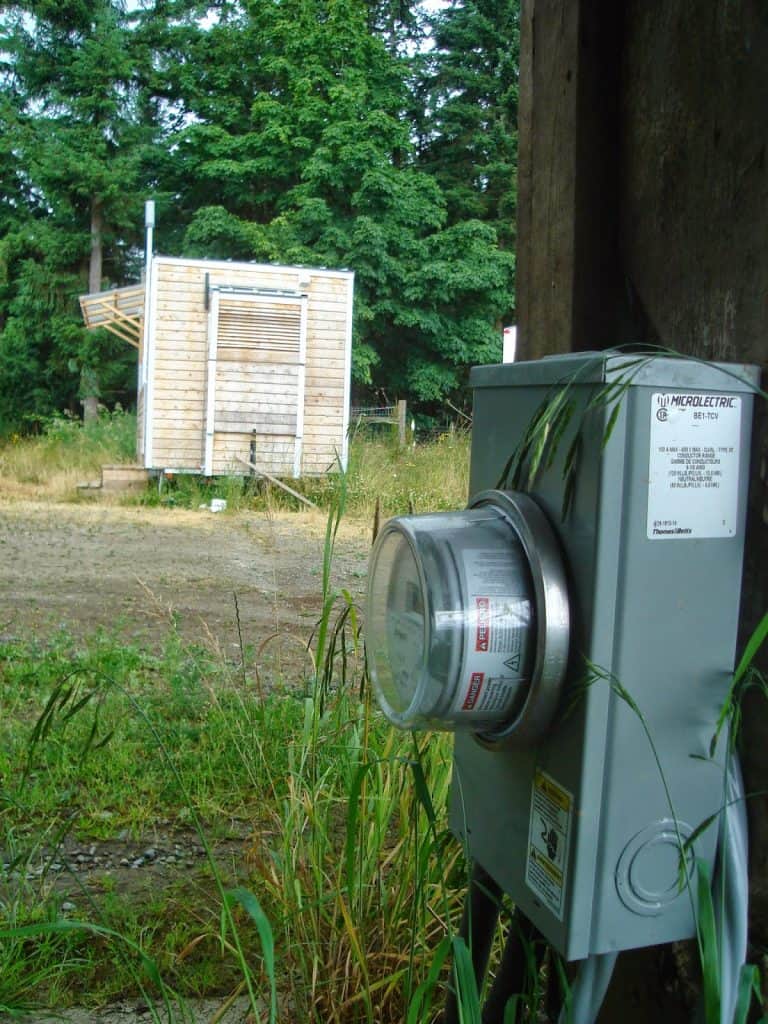
A regular house has 200 amps so what I did was take 100 amps off the house on this property with my own 100 amp panel.
My tiny house is probably running on just over 60 amps so we went with 100 to be safe (we did not actually do the math on this one).
Often rural properties in BC have 2 x 200 amps if they have a barn or small cottage on the land. Therefore, it is not too hard to find someone that has the amps to spare.
A lot of people here use wood heat and gas stoves so they can spare the electricity even on the main house.
The picture (right) is my submeter. I’m about 300 feet from the house that I hooked up to (I’m also losing some amps there from the distance, but we did not measure how much).
My submeter just measures how much power I am using. None of this was done through the power company nor were they informed of this. I am not on a separate bill – I just use the meter reading to know how much of the main house’s electric bill I need to pay.
Between the submeter and my house, the electric and internet cables are buried underground.
A mobile home park supplies either 60 or 100 amps and trailer parks provide 15 – 60 amps, depending. They would also supply fresh water and a hook-up to sewage/septic.
Costs of using all Electic
In the winter when I crank the heat I was paying about $130 a month. Now it’s about $50 per month (Spring).
It’s better to take your electricity off an old cottage or barn that is not being used much because if you have a two-tier payment system for the electricity you are paying double the rate – as you will push the usage over to the second tier every month.
This is a pretty major consideration as it can cost you up to 60$ a month extra.
Tiny House Panels
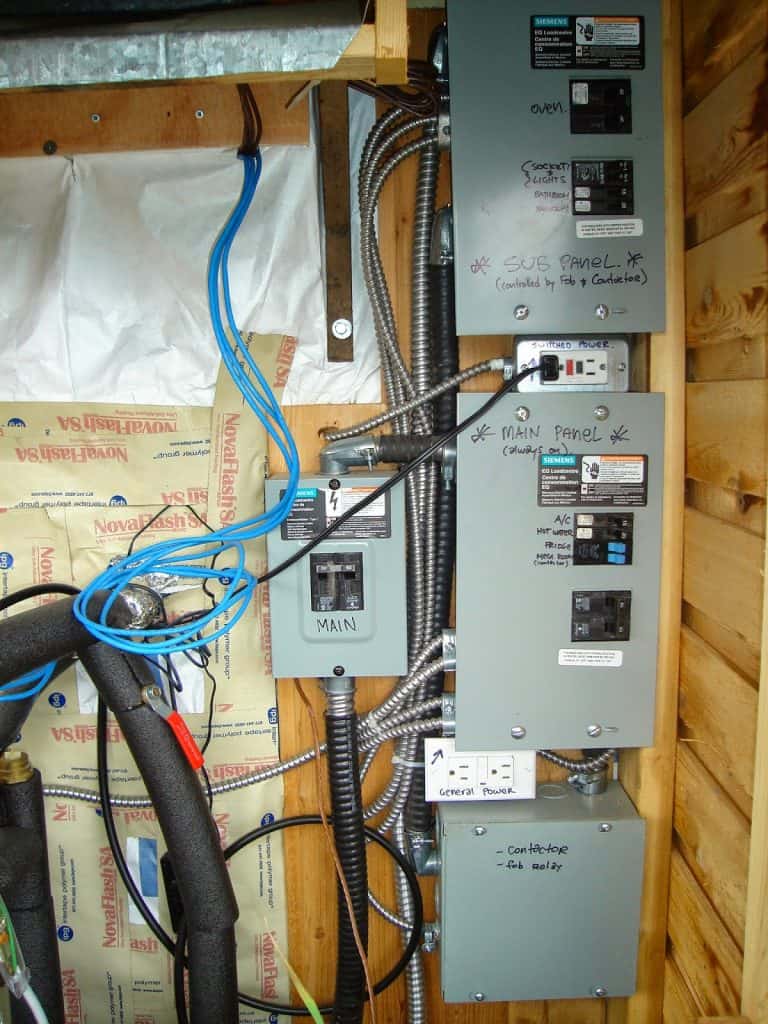
Here are my panels in my utility closet. I have two panels – one for essentials that one is always on and one that can be turned off at night. As you can see in the pic what goes off at night is the oven, lights, sockets, and bathroom.
What stays on is the heat/AC, hot water, fridge, and mechanical room. The panel that can be turned off is controlled by a fob (a garage door opener that can be used from the comfort of my bed).
The same effect can be had from going out to the panel and turning off the unessential switches at night. But this involves going outside twice a day.
Two tips, if you have a composting toilet you are going to need that on all night (otherwise it smells) so make sure you put that on the right panel. One more tip is to have the default position as “on” for the subpanel. When my power goes off I need the fob to bring that panel back on.
There are also two sockets outside one that is connected to the permanent panel and one that can be switched off. It’s been very handy to have these two outlets in the shed for internet, heat tape (below) and for plugging in my travel trailer).
Reducing EMFs
The utility closet is separate from the house and on the opposite side from the bedroom in order to reduce EMFs. You can put foil or another EMF barrier in that wall and that will slightly shield you as well.
Having a sub panel you can switch off makes more sense in a big house where you can get some distance from the kitchen, heating system, etc. I don’t currently turn off the non-essential subpanel at night, as it does not make a difference for me.
One thing you can try is to switch off the individual breakers to your bedroom and other non-essentials at night (and definitely switch off the Wi-Fi and put your cell phone on airplane mode) and see if that helps you sleep better.
I also keep my modem out there in the utility room and it works perfectly fine in the humidity and in -10 C weather. This way it is as far from the bedroom as possible. I keep the wi-fi off at all times.
My house is wired with ethernet cables and there are three different outlets so that I can use the internet anywhere in my house. Wi-fi definitely affects my heart rate and sleep. (Note this is not the usual way to wire internet – you want the thick black cable to hook up to a modem outside and only have the ethernet cables running inside.)
The cable company was nice about running the cable 300 feet from the house out to my trailer where I am essentially squatting. The part where it had to be buried was up to me to do.
I use these filters to cut down on the buzziness and this helps, you can measure it and check.
Water – Incoming
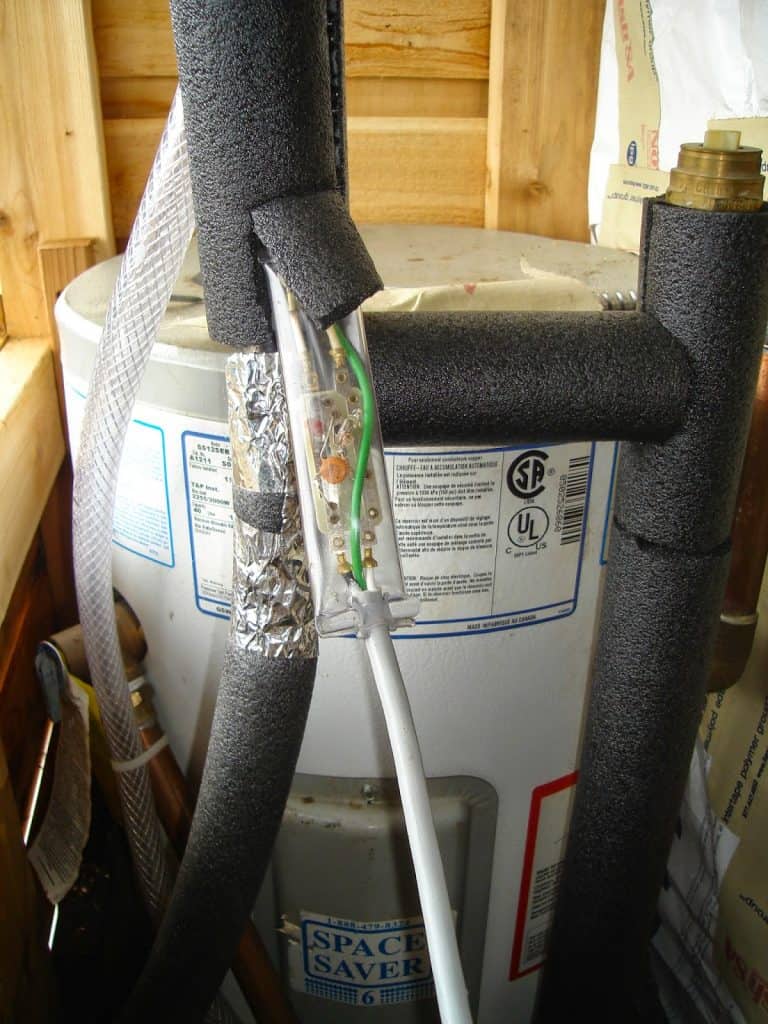
Here is a picture of my 40-liter electric hot water tank. It’s pretty small but works great for two people. It did not freeze in -10 C weather even though it is outside. If it does freeze it will crack and have to be replaced.
My water source is a hose that runs 100 ft above ground from an outdoor faucet. My hose has a heat tape on it which is that white cord coming off the pipes. Over the heat tape is insulation. This kept it from freezing in -10 C. The heat tape is plugged into one of the outlets in the utility shed only when it’s below freezing out.
Wastewater
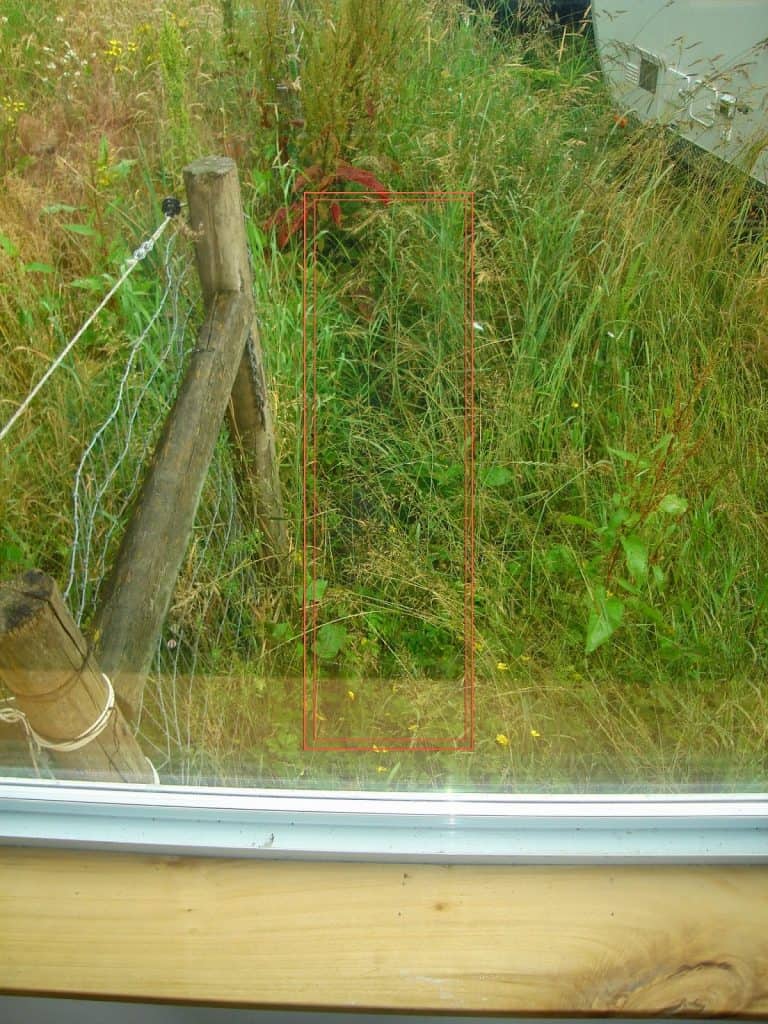
Here on the left is a not so great picture of where my greywater goes. (I have no blackwater because I have a composting toilet.)
All the water from the shower and two sinks goes into a pit that is just outside my house. It is so overgrown with plants that it is very well disguised and impossible to take a picture of.
In the winter though you can see it and if you are trying to avoid inspectors seeing it you will need to come up with another way to hide it in winter.
The red rectangle shows how big it is. It is not very big at all, about 1 ft x 4 ft. The size has not caused me any problems as it is. I have had to go out and remove the sludge that builds up a couple of times in the last 8 months.
I don’t have any filter on it that prevents oils/grease/food particles/hair conditioner from going straight into the pit.
Heating and Cooling
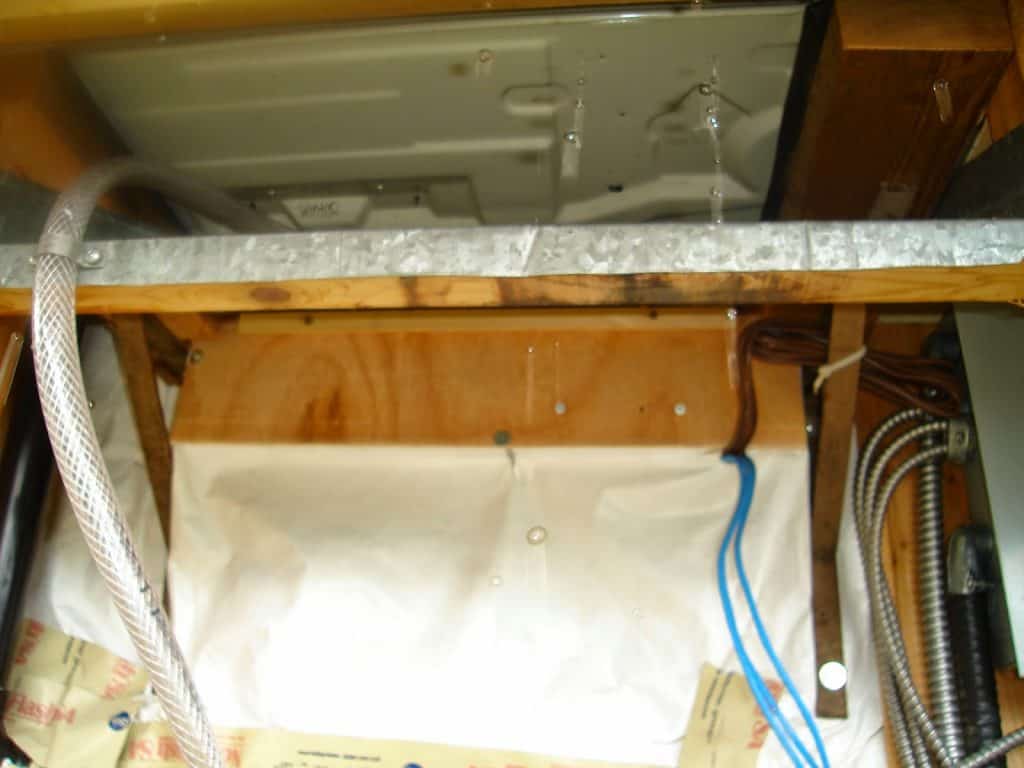
My heating system was initially a Diamond Air 12K BTU heat pump. Pictured right, it was tucked in the top part of my utility closet. I would not recommend this brand at all since it is very low quality, broke very quickly and the company did not respond to requests about the warranty.
My builder also made the mistake of enclosing the outside unit in a utility shed. This was a big mistake. I was also very cold in the winter and I don’t know if this was because 12K BTU was insufficient or if the heat pump was just not working well. I have replaced it with a good quality brand (go with Daikin or Mitsubishi) 15K BTUs.
A mini-split heat pump is a great choice for a tiny house as it provides heating and cooling without any ducting. It has a dehumidifying mode but it does not pull moisture from the air – it is simply an adjusted AC setting.
I also have two extractor fans, one above the stove and one above the shower to remove excess moisture from the air and that works well to keep my humidity levels in the safe zone.
Corinne Segura holds certificates in Building Biology, Healthier Materials and Sustainable Buildings, and more. She has 10 years of experience helping others create healthy homes.
Did you find this post helpful? If so you can buy me a coffee to support the research behind this blog. Thank you!
Unknown
What happens to the composted toilet by product. I've been looking at the Villa by Separete which splits the two wastes. Feces goes decomposing bag with solar exhaust to dry/compact it. The urine either goes to a small tank or plumbed out. By not mixing the two you avoid fermentation. The bag/feces is buried in the earth and supposed to decompose in 6 months. A single person would use about 1 bag a month.
Corinne
We have special compost piles for those here. But I think some ppl just put them in the trash.
Thomas Venney
Thanks
Susie Matthews
very impressed with the technical side of things – I've been wondering about grey water run off – you've inspired me to think of a french drain and 'dry riverstone bed' combination surrounded with marsh plants – using natural based hair/body products. This has to be one of the most informative articles so far – thank you.
Barbara Powers
To Susie: I was fascinated by your comment re French Drain and marsh plants. Since I am in AZ, I wouldn’t be able to do marsh plants, but you inspired me to think about your idea. I already have a French Drain installed around permitter of back of house to keep from getting flooded during monsoons. Do you know where I could find more info re getting my showers and sinks to drain into the French Drain and then direct the water to a spot where I could put in plants, but not have to pay for the water.
Anonymous
You must’ve been very busy. Because the planning and the implementation for the wastewater and electrical system on your house requires a lot of time to work on and patience to ensure that it has been installed and working properly. But looking at it now, it’s all worth it. And I hope it will continue to progress smoothly for you, so that you can enjoy it soon.
Kelley Burton @ Aim Dynamics